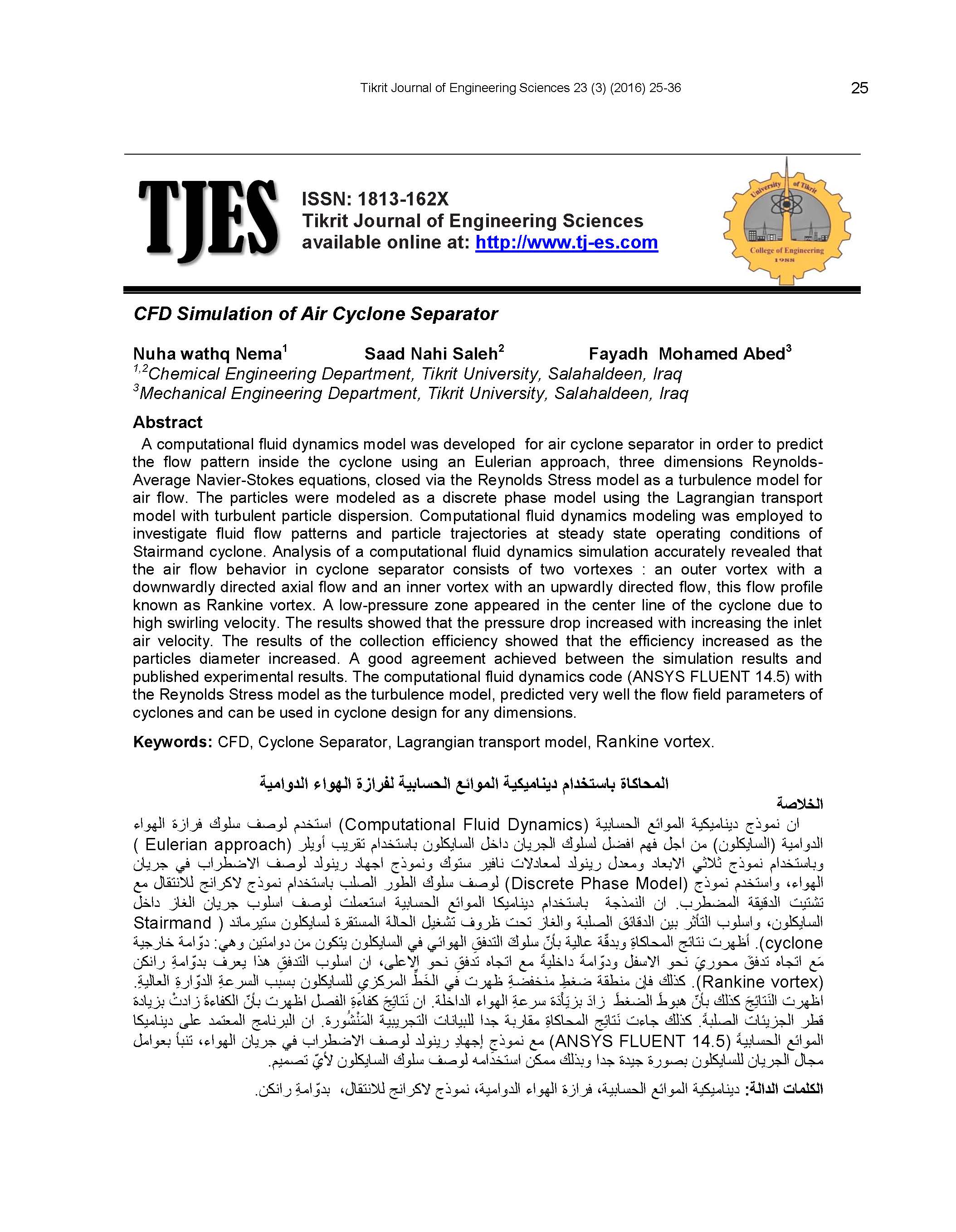CFD Simulation of Air Cyclone Separator
Main Article Content
Abstract
A computational fluid dynamics model was developed for air cyclone separator in order to predict the flow pattern inside the cyclone using an Eulerian approach, three dimensions Reynolds-Average Navier-Stokes equations, closed via the Reynolds Stress model as a turbulence model for air flow. The particles were modeled as a discrete phase model using the Lagrangian transport model with turbulent particle dispersion. Computational fluid dynamics modeling was employed to investigate fluid flow patterns and particle trajectories at steady state operating conditions of Stairmand cyclone. Analysis of a computational fluid dynamics simulation accurately revealed that the air flow behavior in cyclone separator consists of two vortexes : an outer vortex with a downwardly directed axial flow and an inner vortex with an upwardly directed flow, this flow profile known as Rankine vortex. A low-pressure zone appeared in the center line of the cyclone due to high swirling velocity. The results showed that the pressure drop increased with increasing the inlet air velocity. The results of the collection efficiency showed that the efficiency increased as the particles diameter increased. A good agreement achieved between the simulation results and published experimental results. The computational fluid dynamics code (ANSYS FLUENT 14.5) with the Reynolds Stress model as the turbulence model, predicted very well the flow field parameters of cyclones and can be used in cyclone design for any dimensions.
Article Details
Section

This work is licensed under a Creative Commons Attribution 4.0 International License.
THIS IS AN OPEN ACCESS ARTICLE UNDER THE CC BY LICENSE http://creativecommons.org/licenses/by/4.0/
References
- Shukla S. K., Shukla P.a., Ghosh P., "Evaluation of Numerical Schemes using Different Simulation Methods for the Continuous Phase Modeling of Cyclone Separators", Advanced Powder Technology, Vol. 22, P. 209-219, 2011.
- Utikar , R., Darmawan, N., Tade, M., Li, Q, Evans, G., and M.a.P. Glenny, V., "Hydrodynamic Simulation of Cyclone Separators, in Computational Fluid Dynamics", H.W. Oh, Editor., In Tech. p. 241-266, 2010.
- Chuah L., Gimbun G., Thomas S. Y. Choong and A. Razi F., "A CFD Analysis on the Effect of Vortex Finder and Cylindrical Length on Cyclone Hydrodynamics and Centrifugal Forces", The Institution of Engineers, Malaysia, Vol. 71: p. 51-58, 2009.
- Sinnott R. K., Coulson & Richardson's, "Chemical Engineering Chemical Engineering Design", Third ed., Vol. 6, Butterworth-Heinemann Oxford, 2003.
- Sylvia N., Yunardi, Maulana I., Elwina, Wusnah and Bindar Y., "Analysis of Turbulence Models Performance for the Predictions of Flow Yield, Efficiency, and Pressure Drop of a Gas-solid Cyclone Separator", Proceedings of The Annual International Conference Syiah Kuala University, Vol. 1, p. 53-60, 2011.
- Hoffmann A. C. and Stein L. E., "Gas Cyclones and Swirl Tubes ,Principles, Design and Operation", Second ed., Berlin Heidelberg New York, 2008.
- Winfield D., Croft N., Paddison D., Craig I., "Performance Comparison of a Single and Triple Tangential Inlet Gas Separation Cyclone: A CFD Study", Powder Technology, Vol. 235, p. 520-531, 2013.
- Corte´s C., Gil A., "Modeling the Gas and Particle Flow Inside Cyclone Separators", Progress in Energy and Combustion Science, Vol. 33, p. 409-452, 2007.
- Flagan R., Seinfeld J. H., "Fundamentals of Air Pollution Engineering", Prentice-Hall, Inc. A Division of Simon & Schuster, 1988.
- Horvath A., C. J., Harasek M., "Influence of Vortex-Finder Diameter on Axial Gas Flow in Simple Cyclone", Chemical Product and Process Modeling, Vol. 3, p. 1-26, 2008.
- Safikhani H. , Behabadi A. M. A. , Shams M. , Rahimyan M. H., "Numerical Simulation of Flow Field in Three Types of Standard Cyclone Separators", Advanced Powder Technology, Vol. 21, p. 435–442, 2010.
- Andersson B., Andersson R., Hakansson L., Mortensen M., Sudiyo R., Wachem B., "Computational Fluid Dynamics for Engineers", First ed., USA, New York: Cambridge University Press, 2012.
- Kegg, S., "A Numerical Investigation of Gas Cyclone Separation Efficiency with Comparison to Experimental Data and presentation of a Computer-based Cyclone Design Methodology", Thesis in Science, Akron, 2008.
- ANSYS, I., ANSYS FLUENT Theory Guide, United States: ANSYS, Inc., 2012.
- Martignoni W. P. , Bernardo S., Quintani C. L., "Evaluation of Cyclone Geometry and its Influence on Performance Parameters by Computational Fluid Dynamics (CFD)", Brazilian Journal of Chemical Engineering, Vol. 24, p. 83-94, 2007.
- Elsayed K., "Optimization of the Cyclone Separator Geometry for Minimum Pressure Drop using Co-Kriging", Powder Technology, Vol. 269, p. 409-424, 2015.
- Versteeg H. K., Malalasekera W., An Introduction to Computational Fluid Dynamics', The Finite Volume Method. First ed., United State: John Wiley & Sons Inc., 1995.
- Jiyuan Tu, Yeoh G., Liu C., "Computational Fluid Dynamics", A Practical Approach. Second ed., USA: Elsevier Ltd., 2013.
- Harwood R., Slack M.,"CFD Analysis of a Cyclone", Fluent Europe Ltd, Sheffield, United Kingdom. QNET-CFD Network Newsletter, Vol. 1, p. 1-6, 2002.
- Wang B., Xu D. L., Xiao G. X., Chu K. W., and Yu A. B., "Numerical Study of Gas-Solid Flow in a Cyclone Separator", Third International Conference on CFD in the Minerals and Process Industries , CSIRO, Melbourne, Australia, 2003.





